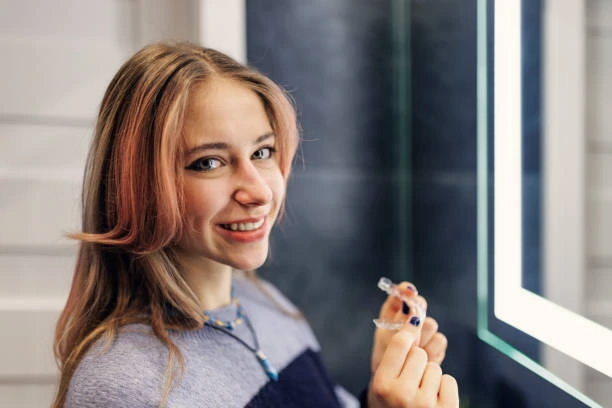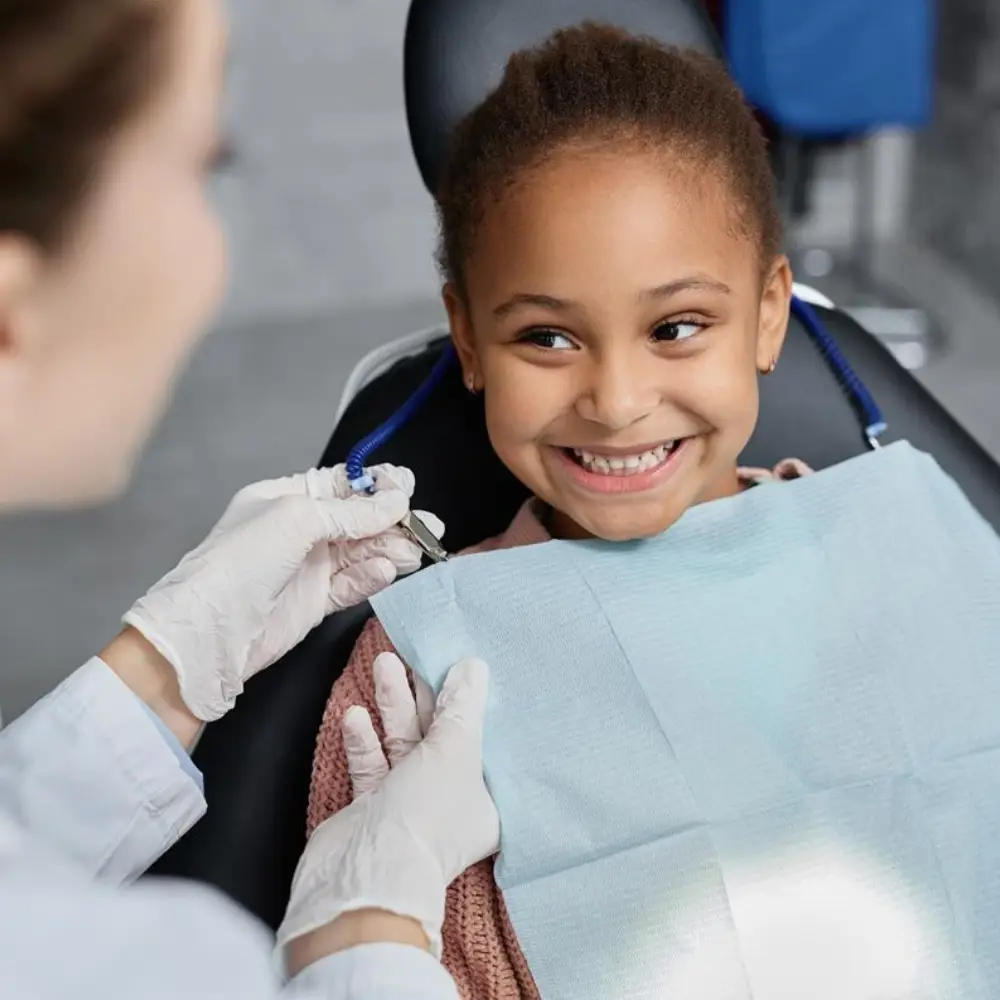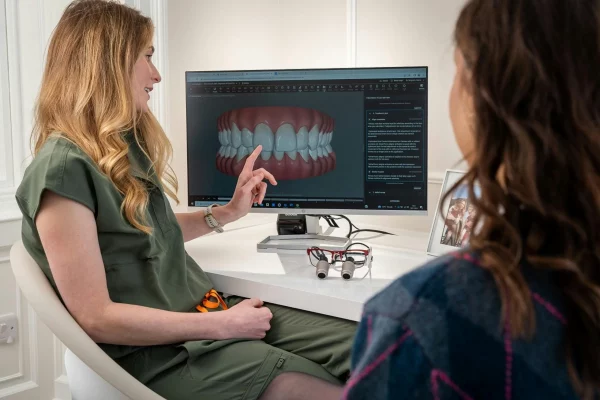Invisalign represents a contemporary and inconspicuous approach to orthodontic treatment, suitable for both adolescents and adults, yet the process is not uniform across age groups. Although the aligners may appear similar, there are critical distinctions tailored to the specific developmental and dental needs of each demographic.
For adolescent patients, Invisalign aligners are equipped with compliance indicators, small blue dots that gradually fade to monitor the duration of wear. This feature facilitates adherence to prescribed usage, which is particularly important during teenage years. Additionally, these aligners are designed to accommodate erupting teeth, addressing the reality that not all permanent teeth may have emerged. Furthermore, since adolescents are still undergoing craniofacial growth, treatment plans typically account for ongoing jaw development to optimize alignment as the individual matures.
In contrast, adult Invisalign treatment primarily addresses dental issues accrued over time, such as crowding, spacing, or relapse following previous orthodontic interventions. As adults possess fully developed jaws and bone structures, treatment may necessitate more extended durations and occasionally more complex tooth movements. Adults often seek Invisalign for both functional and aesthetic reasons, with the discreet appearance of the aligners proving particularly advantageous in professional and social contexts.
Despite these variances, both adolescents and adults benefit from Invisalign’s advanced technology, comfort, and discreet design. Treatment plans are meticulously customized to address the unique dental circumstances of each patient, ensuring effective and individualized care.
Invisalign for Teens vs. Adults: What’s the Main Difference?

Invisalign treatment, while fundamentally utilizing custom, clear aligners to reposition teeth, varies notably between adolescent and adult patients. For adolescents, aligners are often designed with additional features—such as eruption tabs to accommodate the emergence of new teeth and compliance indicators to monitor wear time. These adaptations address the dynamic developmental stage of teenagers, whose jaws and dentition may still be evolving. Orthodontists must therefore regularly reassess and modify treatment plans to account for ongoing growth.
Conversely, Invisalign for adults focuses on teeth and bone structures that have reached full maturity. Treatment in adults frequently targets persistent alignment concerns, bite irregularities, or relapse from previous orthodontic interventions. Since growth is no longer a factor, the approach prioritizes precise tooth movements and, at times, extended treatment durations or supplementary attachments to achieve optimal results.
Despite these distinctions, both demographics benefit from Invisalign’s discreet appearance, comfort, and personalized treatment strategies, which are adapted to suit the specific orthodontic requirements of each patient.
Compliance Indicators and Wear Time Expectations
One of the main challenges in orthodontics is ensuring patients wear their aligners as prescribed. Teens may struggle more with this responsibility due to busy schedules, forgetfulness, or simple lack of routine. To help, Invisalign for teens includes compliance indicators—small, blue-colored dots that fade as the aligners are worn. This allows both parents and orthodontists to monitor how consistently the aligners are being used.
For both teens and adults, the recommended wear time is 20–22 hours per day. However, adults often have an easier time maintaining compliance, as they typically have more control over their schedules and motivation tied to personal or professional appearance.
Teen Invisalign Features You Won’t Find in Adult Versions
Invisalign designed its teen aligners with several distinct features tailored specifically for younger patients. For instance, eruption tabs are integrated into the aligners to accommodate teeth that have yet to fully emerge, which helps guide proper alignment as dental development progresses. Given that adolescents are prone to losing or damaging their aligners, treatment packages typically include replacement sets, addressing a common concern for this age group. Furthermore, parental monitoring tools are available, enabling orthodontists to generate progress reports using data from the compliance indicators, thus providing parents with reassurance regarding adherence to the prescribed treatment plan.
For adult patients, these additional features are generally unnecessary. Adults have completed dental development, so there is no need to make allowances for erupting teeth. They also tend to be more reliable in consistently wearing their aligners and are less likely to misplace them, reducing the need for extra replacements or intensive compliance tracking.
Bone Development and Orthodontic Timing
Teens are still in the growth phase, which can make orthodontic movement more efficient. The flexibility in their developing jawbones often allows for faster, more significant changes compared to adults whose bones have fully matured. For adults, certain types of corrections may take longer or require additional techniques due to the stability of mature bone structures.
Treatment Time: How Long Does Invisalign Take for Teens vs. Adults?
When it comes to Invisalign, the duration of treatment is a frequent concern among patients and their families. While Invisalign is widely recognized for its discreet aesthetic and adaptability across age groups, the treatment timeline is not universal. Variables such as age, jaw development (especially relevant for adolescents), the degree of dental misalignment, and, crucially, the patient’s adherence to wearing the aligners consistently can all impact the overall length of treatment. Recognizing and accounting for these factors enables both clinicians and patients to establish realistic expectations and work collaboratively toward optimal results.
Why Teens Often Finish Faster Than Adults
Because of ongoing growth and flexibility in bone structure, teens often complete their Invisalign treatment more quickly than adults. A typical case for a teenager may take 12–18 months, whereas adults might need 18–24 months depending on complexity and lifestyle factors. Teens’ biological responsiveness means their teeth may move more easily, particularly if they adhere closely to wear-time guidelines.
Adult Lifestyle Factors That Affect Invisalign Duration
For adults, life can sometimes interfere with consistent aligner use:
- Busy work schedules and meetings may lead to extended periods without aligners.
- Social events may prompt some to remove aligners more frequently.
- Adults may have more complex dental issues, such as restorations, gum recession, or bone loss, requiring more precise, gradual adjustments.
These factors can lengthen the treatment timeline, even for otherwise cooperative adult patients.
Tips to Stay on Track With Your Treatment Timeline
Regardless of age, whether adolescent or adult, maintaining certain disciplined habits is essential for successful Invisalign treatment.
- Aligners should be worn consistently for 20 to 22 hours daily. Adherence to this schedule is crucial, as the efficacy of tooth movement relies heavily on prolonged wear.
- Patients must transition to each subsequent set of aligners precisely according to their provider’s timeline. Deviating from the recommended schedule can disrupt the progress and compromise treatment outcomes.
- Limit frequent snacking. Each instance of eating necessitates removal and reinsertion of aligners, which may inadvertently reduce overall wear time and diminish effectiveness.
- Aligners should always be stored in their protective case when not in use. This practice helps prevent loss, breakage, and accidental damage, thereby safeguarding the investment in treatment.
- Attending all scheduled check-ins with the orthodontist or dentist is imperative. These visits enable the provider to monitor progress and implement necessary adjustments, ensuring optimal results.
Diligent adherence to these guidelines will facilitate a more efficient and successful Invisalign experience.
Cost of Invisalign: Is It Different for Adults and Teens?
The financial aspect of opting for Invisalign cannot be overlooked, as it frequently plays a significant role in the decision-making process for both adolescents and adults. Although the underlying technology remains consistent, pricing is subject to variation based on age-related factors such as treatment complexity, duration, and the inclusion of features like compliance indicators for teens. Adult cases may present additional challenges or require extended treatment, potentially increasing the overall cost.
Furthermore, insurance coverage is not uniform and may influence final expenses. An understanding of these distinctions is essential for making an informed choice and for effective financial planning.
Invisalign Cost Breakdown for Each Age Group
The price for Invisalign generally depends more on case complexity than age. On average:
- Teens: $3,000–$5,500
- Adults: $3,500–$6,500
Adults may occasionally incur higher costs if additional procedures like tooth extractions, gum treatments, or bone grafts are needed beforehand.
Insurance and Financing for Teens vs. Adults
For teens, dental insurance plans often offer partial coverage as part of orthodontic benefits. Adults may find their coverage more limited, particularly if their dental policy does not include orthodontic benefits for individuals over 18. Fortunately, many clinics including G&P Dental offer flexible financing plans, allowing patients of all ages to spread payments over time.
Are There More Affordable Options for Teen Invisalign?
Some orthodontic practices extend discounts or promotional rates for teen Invisalign, especially when treatments are bundled as part of a family care plan. In addition, many offices recognize the financial considerations families face and offer payment plans designed to accommodate a range of budgets.
Invisalign Before and After: What Results to Expect
Observing the progression of Invisalign treatment is genuinely fascinating. Initially, patients may present with various dental concerns such as misaligned teeth, gaps, or bite irregularities. These issues often impact not only the aesthetics of one’s smile but also overall oral health and function. Throughout the Invisalign process, gradual improvements become evident, ultimately resulting in a more harmonious bite, enhanced dental health, and increased confidence. Being aware of the expected changes and challenges, from initial discomfort to the eventual transformation, allows individuals to approach their Invisalign journey with preparedness and motivation.
Realistic Outcomes for Adults With Complex Cases
Many adults seek Invisalign treatment later in life to address persistent dental concerns, such as crowding, spacing issues, malocclusions (including overbites and underbites), or shifting teeth following previous orthodontic interventions. While the results for adult patients can be quite satisfactory, the process often necessitates a longer duration of treatment. Additionally, achieving optimal outcomes may require a greater number of aligners or supplementary procedures, such as enamel recontouring or the use of attachments, to ensure precise tooth movement and alignment.
Early Intervention Benefits for Teen Smiles
Early orthodontic intervention during adolescence offers significant benefits. By addressing jaw development at this critical stage, practitioners can often prevent the need for extractions or surgical procedures later in life. Additionally, correcting bite issues early helps to mitigate complications that could otherwise become more severe over time.
Therapeutically, such interventions enhance functional outcomes, including improved speech, more effective chewing, and enhanced facial symmetry. Importantly, fostering a healthy, attractive smile during formative years can substantially boost self-esteem and psychosocial well-being.
Case Study: Comparing Two Generations’ Results
Consider a mother-daughter Invisalign journey:
- The daughter (age 14): Finished treatment in 14 months with minimal attachments, guided by natural growth patterns.
- The mother (age 42): Required 22 months, with additional attachments and IPR (interproximal reduction) to correct crowding and bite misalignment.
Both achieved excellent results, but the daughter’s early treatment allowed for quicker, simpler corrections.
Invisalign Near Me: Choosing the Right Provider by Age Group
Conducting a search for “Invisalign near me” is often merely an initial step in pursuing orthodontic care. Selecting an appropriate provider is equally, if not more, significant, particularly given the differing needs of teens and adults. Adolescents may require a provider well-versed in teen orthodontics, while adults often benefit from practitioners experienced in managing complex cases that arise later in life. Identifying a provider equipped with specialized knowledge, advanced technology, and a nuanced understanding of age-specific requirements is essential for achieving optimal, individualized treatment outcomes.
Why G&P Dental Offers Tailored Plans for Teens and Adults
At G&P Dental, we recognize that each patient’s experience with Invisalign is unique, shaped by factors such as age, jaw development, lifestyle, and adherence to treatment protocols. Accordingly, our approach is not one-size-fits-all; we design individualized plans that address the specific needs and challenges of each case, whether related to growth, daily routines, or long-term stability.
By integrating advanced digital scanning tools, evidence-based treatment planning, and comprehensive patient education, we strive to ensure optimal progress throughout the Invisalign process. Our objective is to facilitate smooth, predictable outcomes tailored to the individual circumstances of every patient.
How to Prepare Your Teen (or Yourself) for Success
Achieving success with Invisalign really comes down to consistent preparation and support. Setting reminders for aligner changes is essential, since it’s all too easy to forget without a prompt. It’s also important to always store aligners in their designated cases—misplacing them can easily disrupt treatment. Maintaining rigorous oral hygiene is non-negotiable. Brushing and flossing thoroughly helps prevent complications like cavities or staining, which can be exacerbated by aligner use. Regular dental checkups and cleanings are equally important, as they allow for early detection of potential issues and help ensure that treatment stays on track.
Open communication with your orthodontic provider is crucial. If any discomfort or unexpected challenges arise, reporting them promptly can help address problems before they escalate. For younger patients, parental involvement is especially helpful. Monitoring compliance indicators and celebrating milestones provide encouragement and reinforce positive habits, ultimately contributing to better treatment outcomes.
Questions to Ask During Your Invisalign Consultation
Before starting Invisalign, it’s important to have a clear understanding of your treatment plan and what to expect. Here are key questions to ask your provider during your consultation:
- How many Invisalign cases have you treated for my age group?
- What is my estimated treatment timeline?
- Will I need additional procedures or attachments?
- What if I lose or damage my aligners?
- How do you monitor treatment progress?
Frequently Asked Questions (FAQs)
1. Is Invisalign more effective for teens than adults?
In some cases, yes, teens may experience faster results because their developing bones and growing jaws allow teeth to move more easily. The flexibility of their bone structure often makes tooth movement more predictable and efficient. However, adults can still achieve excellent results with Invisalign. Since adult bones are fully developed, treatment may take a bit longer and often requires more detailed planning and precision. Regardless of age, both teens and adults can enjoy a beautifully aligned smile with the right treatment approach.
2. Are there any risks for teens using Invisalign?
Invisalign is generally safe for teens when used correctly and under professional supervision. The biggest concern is non-compliance, as not wearing the aligners for the recommended time can slow or even stall progress. Maintaining proper oral hygiene is also essential since food particles can get trapped if aligners aren’t cleaned regularly. Routine dental checkups help monitor both tooth movement and overall oral health, reducing the risk of issues like cavities or gum inflammation. With good habits and regular care, most teens complete Invisalign treatment successfully and safely.
3. Can adults get the same results as teens with Invisalign?
Yes. While adults may experience slightly slower tooth movement or face more complex alignment issues, Invisalign remains a highly effective solution. With fully developed jaws and dental structures, treatment often requires careful planning and precision. Fortunately, experienced providers can customize treatment plans to address adult-specific concerns, such as bite issues or previous orthodontic relapse. With proper care and compliance, adults can achieve excellent, long-lasting results with Invisalign.
4. Does Invisalign cost more for adults?
Adults may encounter slightly higher costs if additional treatments, like attachments or refinements, are needed to address complex alignment issues. However, the base price for Invisalign is often quite similar between teens and adults. The main cost differences usually reflect the complexity of the case rather than the patient’s age. For example, adults with long-standing bite problems or relapse from previous orthodontic work may require more detailed planning. Regardless of age, a personalized consultation will provide the most accurate cost estimate.
5. What happens if a teen forgets to wear their aligners?
Missing wear time can slow down tooth movement and potentially impact the final results of Invisalign treatment. For teens, compliance indicators built into the aligners help both parents and orthodontists track whether the aligners are being worn as prescribed. If lapses occur, orthodontists can adjust the treatment plan to get progress back on track. Parents play a key role in reminding and motivating teens to wear their aligners consistently. Staying on schedule helps ensure the best possible outcome in the shortest time.
At G&P Dental, we believe everyone deserves a confident smile, whether you’re a teen starting early or an adult finally making the investment in your dental health. Invisalign offers a flexible, virtually invisible solution for all ages, with customized care every step of the way.
If you or your teen are considering Invisalign, schedule your consultation with our experienced team today. We’ll guide you through the process, answer all your questions, and design a treatment plan that fits your unique smile goals.


